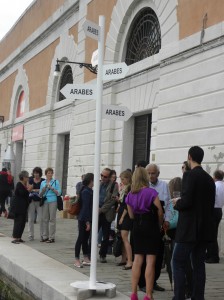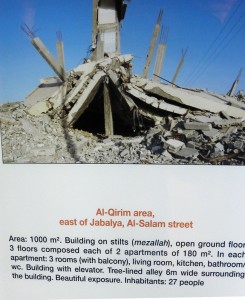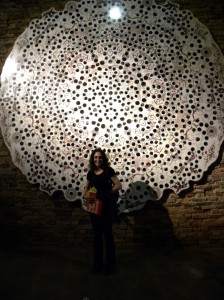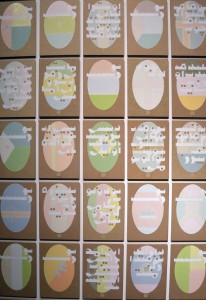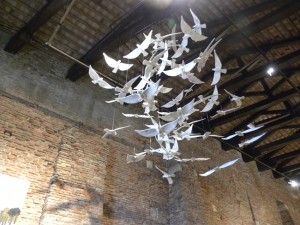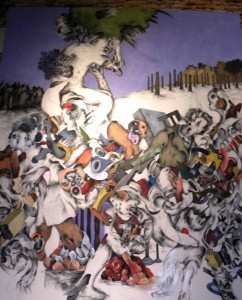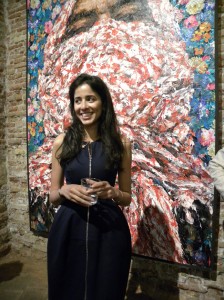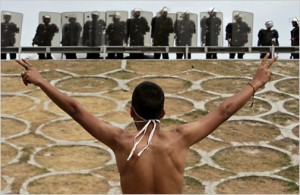Venice Biennale Part 4: The Future of a Promise Contemporary Art from the Arab World
What a wonderful name for this pavilion at this point in history. And the name was created before the Arab spring in December according to the curator Lina Lazaar. But the pavilion definitely has a sense of exhilaration in many of the works. There is no theme that ties the work together, although several of them address travel and borders. But what is obvious is that contemporary art from the Arab world can go in any direction as suggested by the signpost by Ziad Abillama with every sign pointing to “Arabes”. The artists are from many countries, and have as many trajectories. Another underlying fact is that contemporary Arab art is a hot commodity, driven by galleries and auctions, as well as collectors based particularly in Saudi Arabia, Qattar, and Dubai, and other wealthy emirates. The current exhibition is funded by a group called Edge of Arabia which is going to publish a book of the same name on the contemporary arts of Saudi Arabia.
The Future of a Promise is an aesthetically compelling show, for the most part not confrontational. Two Palestinian artists make acute work about housing issues. Taysir Batniji in particular created a riveting photographic installation, GH 0809, an abbreviation of Gaza Houses 2008 – 2009 (right after the Israeli invasion of winter 2008-09). He co- opts the format of real estate advertising to present listings of houses in the Gaza strip, many of them ruined, with comments like “building on stilts… beautiful exposure, inhabitants 27 people.” His subtlety makes one aware of both the absurdity of the listing, as well as the ruinous situation in Gaza, where materials for reconstruction have been blocked (although that is finally changing following the Egyptian change in government).
Yazan Khalili’s Colour Correction adds bright colors on the buildings of the Al-Amari Refugee Camp located as he says “inside/beside/outside Ramallah City.” He speaks of the “unbearably unstable relationships between Palestinians and their surrounding landscape.” By adding day-glo pink, turquoise, purple,green, orange, on the buildings he is suggesting both the tragedy and the possibilities for a better future.
Another artist who dazzles us with an enormous work based on personal trauma and embedded in Middle Eastern culture is Lara Baladi.
As her father died of cancer, she documented the residue in coffee cups from visitors to the family in order to predict the future. Rose is a large abstract work that includes representations of six months of these residues. The large scale and specific imagery give it resonance.
Several of the artists addressed travel: Emily Jacir’s Embrace, appears to be a circular luggage conveyor that moves as you approach it, but which, in its emptiness, suggests futility; Raafat Ishak’s Responses to an immigration request from one hundred and ninety four governments.in 194 panels includes the flag of each state rendered in intentionally insipid pastels, with a summary of the repetitive responses ( or a blank if there was no response). The homogeneity of bureaucracy around the world and its ability to obstruct individual freedom is the theme. Third, and most offbeat is Manal al Dowayan’s Suspended Together. 200 fiberglass doves frozen in place in the installation. Each one is covered with the document required for Saudi women to travel (with a male relative), underscoring that no matter how powerful women become, the restrictions on their travel in the Arab world still exist everywhere. (It is intriguing that the Saudi pavilion has two women as the artists, with an emphasis on their world wide travel.)
And of course as painters, Ayman Baalbaki with his extraordinary surfaces depicting just the faces of freedom fighters wearing the characteristic keffiye and Ahmed Alsoudani’s frightening images of disaster, are entirely different in technique, but equally compelling as art.
Altogether there were 22 artists each addressing a different topic in a different medium. The real message of the show was to demonstrate the sophisticated range of art from the Arab world, carefully not called “Arab art.” Some of these artists have been expatriots for decades, others are still living in their country of origin, some are in places of conflict, others in cities of great wealth. Some are religious followers of Islam, others are Christian. All of the works are understandable to an uninformed viewer who is not Arab. Is this therefore simply contemporary art that happens to come from artists who have Arabic roots, and marketable in the international market since it does not challenge or obscure. There are many many artists who could have been included. Why were these chosen?
The curator, Lina Lazaar, poses the question “Can visual culture . . . respond to both recent events and the future promise implied in these events?” The future promise is the demands of the recent protestors in the Middle East for democracy, freedom to speak their minds, freedom to participate in their countries, to replace authoritarianism with governments responsive to the people, to have economic opportunity, even just employment. Do these works address that? Sometimes. Is the repression of those desires what lies in the future. In some cases. Is that indicated here? Occasionally.
It is intriguing to compare this to the Iraqi pavilion (and Alsoudani appears in both), in which the artists’ anguish comes through clearly as does a coherent and urgent subject, in equally successful art. The shift in the relationship of art to politics is subtle. At what point are artists willing to push us further? At the point of events such as the complete tragedies in Gaza and Iraq. At the point of the urgency of the young media artist Ahmed Basiony killed in Tahrir Square. At the point of Ai Wei Wei’s exposure of the arrests of Chinese intellectuals on social media. He has been courageously standing up for everyone else who is silent. Thank goodness he has been released. He stands as an example of what is necessary for the future promise to be realized. To stand up for what we believe in. The young workers of the Arab world have been doing just that. Let us hope that artists can be real partners in these hoped for futures as often as possible.
This entry was posted on June 23, 2011 and is filed under Contemporary Arab Art. Venice Biennale.

